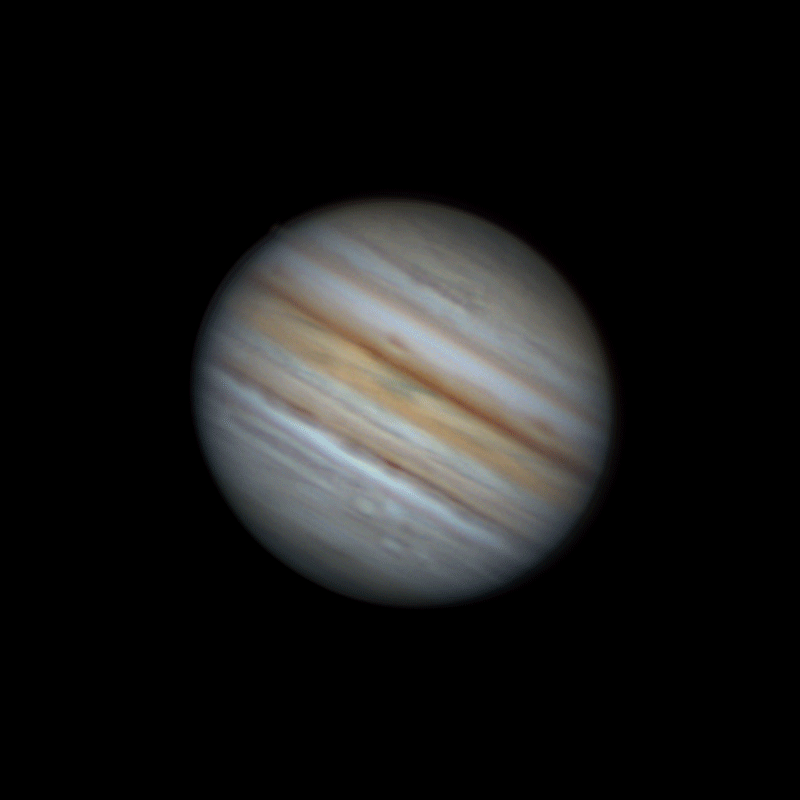Jupiter
Jupiter Goes Missing?!
It may be hard to believe, but there don’t seem to be many – if any – photographs of Jupiter from the “film age” of photography at SRO. On the other hand, did you ever see a really good photograph of the planets from that era, either from a well-provisioned observatory professional or dedicated amateur? The likely answer is “no,” at least by today’s standards.
The reasons why that might be so are given on the “Planets” astrophotography page but to summarize, it was really tough to get a single shot in which that much atmosphere – the column of air in front of the mirror – was perfectly steady for the duration of the exposure. It should also be mentioned that the graininess of film sensitive enough for these comparitvely dim objects (as compared to well lit Earthly subjects) also made sharp imagery virtually impossible.
But lots has changed in the last 60 years. Now, film is “out” and “Digital” is “in.”
A Jovian Challenge
Jupiter is perhaps the perfect target for initiating a new and dedicated planetary imaging effort with the Carroll telescope, for modern tools have the potential to greatly mitigate the highly problematic issue of poor seeing. To spur interest, a Member’s animation project is featured below, this obtained with personal equipment away from Stony Ridge.
The gauntlet has now been thrown down, SRO observers: what can you bring down from the mountain? Let’s find out!

Callisto Comes Out of Hiding
John Rogers
In one captivating and apropos demonstration, you can see how digital photgraphy has eclipsed and supplanted film-based captures, a revolution now over 30 years old. John Rogers' animation encompasses many of the facets brought about by the maturation of this new paradigm.
Aside from sketching at the eyepiece, permanent recording of such intracacies as subtleties in coloration, cloud festooning, or surface markings on a Jovian moon like Callisto, was simply impossible using ground-based emulsion photography. The advent of digital means - cameras and software - changed everything within the span of a generation.
This sequence covers a little over one hour with Jupiter's relatively rapid rotation quite obvious, a factor which must be taken into account during planning for the shoot and the image processing which follows. This video file consists of seven keyframes with interpolation in between. Each of the septet was the result of taking the best 50% of a 10,000 frame movie and then aligning and stacking the five thousand into a single image for which wavelet processing was applied to reveal fine structure. Additional software was employed to do final touchup and string all the frames together.
Under conditions of very good seeing, Rogers used his personal telescope and imager for this project, a 12" Schmidt-Cassegrain variant operating at f/20 and outfitted with an ASI 224MC camera. His contribution represents a rare exception to the imagery on this site which is principally dedicated to results from the 30-inch Carroll reflector. But John's mastery of the process and the dedication it took to produce this media is being featured as an incentive to help encourage greater exploration of SRO's facilities for planetary imaging using modern tools. It's a pursuit whose time has surely come.

Callisto Comes Out of Hiding
John Rogers
In one captivating and apropos demonstration, you can see how digital photgraphy has eclipsed and supplanted film-based captures, a revolution now over 30 years old. John Rogers' animation encompasses many of the facets brought about by the maturation of this new paradigm.
Aside from sketching at the eyepiece, permanent recording of such intracacies as subtleties in coloration, cloud festooning, or surface markings on a Jovian moon like Callisto, was simply impossible using ground-based emulsion photography. The advent of digital means - cameras and software - changed everything within the span of a generation.
This sequence covers a little over one hour with Jupiter's relatively rapid rotation quite obvious, a factor which must be taken into account during planning for the shoot and the image processing which follows. This video file consists of seven keyframes with interpolation in between. Each of the septet was the result of taking the best 50% of a 10,000 frame movie and then aligning and stacking the five thousand into a single image for which wavelet processing was applied to reveal fine structure. Additional software was employed to do final touchup and string all the frames together.
Under conditions of very good seeing, Rogers used his personal telescope and imager for this project, a 12" Schmidt-Cassegrain variant operating at f/20 and outfitted with an ASI 224MC camera. His contribution represents a rare exception to the imagery on this site which is principally dedicated to results from the 30-inch Carroll reflector. But John's mastery of the process and the dedication it took to produce this media is being featured as an incentive to help encourage greater exploration of SRO's facilities for planetary imaging using modern tools. It's a pursuit whose time has surely come.







